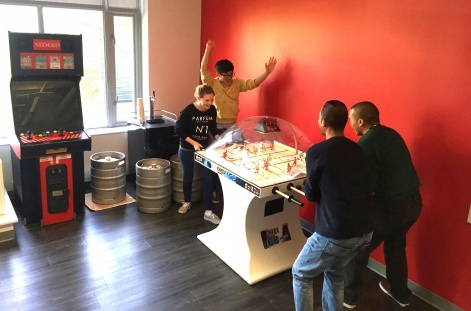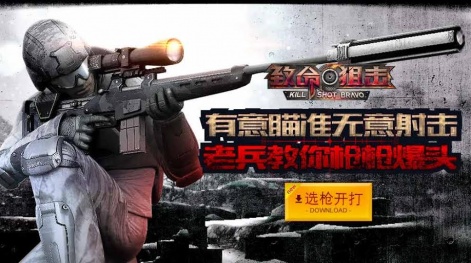With its Kill Shot series hitherto taking a military FPS style, Vancouver studio Hothead Games was ready for a change.
Its latest launch, Kill Shot Virus, gives the IP a post-apocalyptic spin with the introduction of marauding zombies to gun down in the series' signature style.
Its predecessors Kill Shot and Kill Shot Bravo have together surpassed 75 million downloads, and Kill Shot Virus is the Hothead's latest step towards its aim - nay, belief - of launching "a top 10 grossing shooter title in the next few years".
But with the series established as one of the leading mobile FPS brands, why did Hothead decide that now was the right time for this zombie-themed outing?
To find out, PocketGamer.biz went behind the scenes on the game's development with Hothead Games Co-Founder and Director of Development Vlad Ceraldi.
PocketGamer.biz: When did you decide to develop a zombie offshoot of your popular Kill Shot series, and what inspired you?
Vlad Ceraldi: The idea for a zombie-themed shooter game had been percolating within the company for a while.
Zombies are obviously a popular theme in the gaming industry - as it is within Hothead - so before we committed to moving forward with it we wanted to make sure that we could add our own unique twist.
All of the Kill Shot games are designed to be played in bite-sized chunks.Vlad Ceraldi
Once we started sketching out some concepts and we came up with the idea to work in the ragdoll physics, that’s when we truly got inspired because we knew the game would be unlike anything else currently on mobile.
Missions in Kill Shot Virus are quick and bite-sized, with the player controlling only aiming and shooting. To what extent do you feel this is important for a mobile shooter?
It’s extremely important. All of the Kill Shot games are designed to be played in bite-sized chunks because we wanted players to be able to complete a mission or two while they’re waiting for the bus or taking a quick break from their jobs.
At the same time, there’s a natural flow to the missions, so that they lend themselves to deeper, longer gameplay sessions as well should a player choose to do so.
As for the player controls, mobile gamers are obviously limited by the fact that the touchscreen is the controller.
We want our players focused on a crazy, fun shooting experience without having to worry about moving a character around the environment.
With Kill Shot Virus, we think we found a nice balance to keep things interesting.
How did you go about designing a shooter for mobile that still feels impactful, and how important are the slow-mo, ragdoll kill shots to this end?
Shooter games are by nature very intense.
Our goal with bringing the genre to mobile in a mainstream way has always been to make sure we capture the same elements that make shooters on console so action-packed and adrenaline-pumping while making them fun and playful at the same time.
The slow-mo “kill shots” and ragdoll physics are a big part of that. It’s moments like those that make the payoff so rewarding.
We’ve literally seen players explode in cheers at the end of a successful mission because of the way the zombies tumble and whirl or explode on their screen.
Why did you decide to implement different mission types, and how did you go about maintaining variety between stages?
Variety is critical for the success of any shooter game.
Variety is critical for the success of any shooter game.Vlad Ceraldi
We tried to mix things up so that players had an appropriate mix of missions, battlegrounds and enemies.
Many other shooter games become boring over time because you’re completing essentially the same missions over and over.
We knew from the very beginning that we needed to avoid that same pitfall.
Unlike in the strategy genre, there is no dominant formula for monetising FPS games. How did you approach monetisation design?
The first priority with monetising FPS games, as with all freemium games, is to make payments completely optional so that non-paying players can still have a great experience.
But then we try to offer a lot of great gear that players will want to purchase, like chest protectors, headgear or tactical greaves.
There are also power-ups like health packs and piercing bullet packs that can make shots more effective or help players recover faster.
Again, these extras aren’t necessary for gameplay, but for the serious player they can make their efforts more effective and rewarding.
How big is the team on Kill Shot Virus and how long was the total development time?
Hothead is focused on the shooter genre and we have our own proprietary game engine. This means that team sizes can quickly ebb and flow as a game project changes.

We have been told by many companies that we have partnered with that our game development cycles are very quick considering the size, depth and quality of our titles.
What did you learn from the soft launch period and what were the biggest changes you enacted as a result?
As with any of our soft launches, we keep a close eye on our retention and engagement metrics to make sure that the game offers the right style of play for its audience.
We changed the focus from longer range sniper missions to more assault rifle gunplay.Vlad Ceraldi
The biggest change was to change the focus of the shooting to more assault rifle gunplay from longer range sniper missions to take advantage of an insane number of zombies on the screen and the new ragdoll physics system.
What's the biggest challenge you faced during the development process?
The largest challenge was to keep the brand strengths of what makes a great Kill Shot game while making a new game that caters to the theme and expectations of an audience looking for a zombie game.
How do you reflect on the game's global launch? Are you happy with the reception thus far?
Absolutely! The game has been very well received so far by players and professional reviewers alike.
It is currently one of the top downloaded games on Google Play and on iTunes, as the game received a high level of store featuring from both Google and Apple.
But most importantly, it has received a high star rating on both app stores, indicating that players really like it.
What have been the biggest markets for the game so far?
We’ve seen massive engagement across the globe already.
Traditionally, the Western markets have been the biggest slice of the pie for us, but we’re already seeing pick-up in Eastern markets as the appetite for killing zombies seems to be pretty universal.

The game is localised in 12 languages so we feel confident in being able to reach players all around the world.
Any early stats/KPIs you're able to share?
We have a company policy to not share internal metrics - well, except that over 300 million zombies have already been put down in Kill Shot Virus by players from around the world!
What's next for Kill Shot Virus?
We’ve already got a lot of updates planned with new content and regions.
In fact, our very next update will include a new region - the Lynn Treatment Facility, where the Children of SEN have surrounded themselves with infected zombies and made the water treatment facility their own personal fortress.
Players will have to put a stop to them and free the imprisoned survivors by completing 40 new Primary Missions. Look for it coming out soon!






















